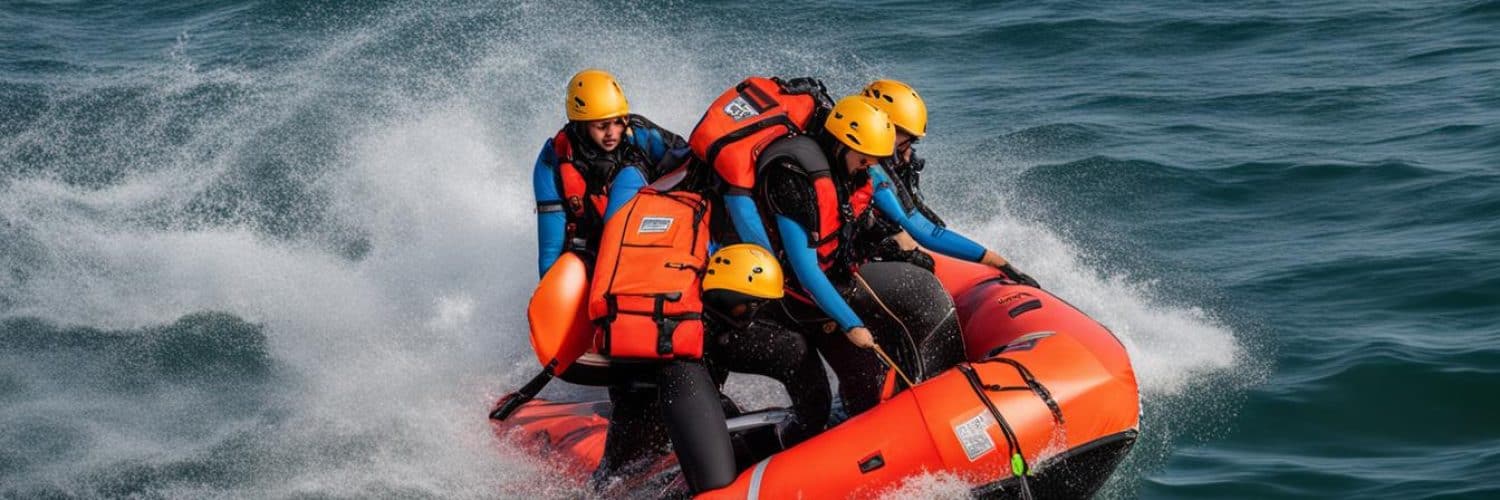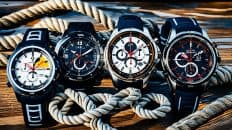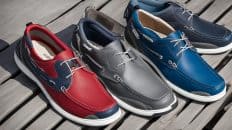Welcome to our comprehensive guide on the fastest-performing approved lifejackets available. When it comes to safety on the water, having the right lifejacket is paramount. Whether you’re boating in rough, remote waters or enjoying a day cruise near shore, a high-quality lifejacket can mean the difference between life and death.
In this guide, we will explore the different types of lifejackets, with a focus on the Type I lifejacket, which is known for its unparalleled performance and protection. We’ll also provide recommendations for the best lifejackets for various boating activities.
Stay tuned as we delve into the world of lifejackets and help you make an informed decision to enhance your safety on the water.
Key Takeaways:
- Type I lifejackets are the fastest-performing approved option available.
- They provide optimal protection and buoyancy in open, rough, or remote water.
- Consider your intended boating activities and comfort preferences when choosing a lifejacket.
- Regularly inspect and maintain your life jackets to ensure they function correctly.
- Stay tuned for our recommendations on the best lifejackets for various boating activities.
Types of Lifejackets
When it comes to lifejackets, there are various options available, each designed for specific purposes and buoyancy requirements. Whether you’re cruising offshore, fishing near shore, or participating in water activities, there is a lifejacket suitable for your needs. Let’s explore the different types of lifejackets:
Type I Lifejackets – The Best for Rough Waters
Designed for open, rough, or remote water, Type I lifejackets provide the highest level of buoyancy and protection. They are ideal for activities such as cruising, racing, and fishing in rough conditions. These lifejackets offer a minimum buoyancy of 22 lbs. for adults and 11 lbs. for children. While they may be bulkier and less comfortable compared to other types, they excel in retaining body heat and ensuring your safety in challenging environments.
Type II Lifejackets – Perfect for Inland Cruising
If you’re cruising, fishing, or sailing on protected and inland water near shore, Type II lifejackets are a suitable choice. With a minimum buoyancy of 15.5 lbs. for adults, they offer moderate flotation. Although they are less buoyant than Type I lifejackets, they provide more comfort and freedom of movement. However, it’s important to note that Type II lifejackets may require the wearer to tread water to keep their head above water.
Type III Lifejackets – Versatile and Reliable
For serious inland and near shore cruising activities, Type III lifejackets are recommended. They offer a minimum buoyancy of 22.5 lbs. for adults and are suitable for boating inshore and participating in supervised activities like sailing regattas and canoeing. While Type III lifejackets are more comfortable than Type I and Type II, they do not guarantee to turn an unconscious wearer face-up. Therefore, they are not recommended for children under the age of 16.
Type IV Lifejackets – Throwables and Supplements
Type IV lifejackets serve as throwable devices, designed to be thrown to overboard victims or to supplement buoyancy. They are not meant to be worn and have a minimum buoyancy of 16.5 lbs. for ring buoys and 18 lbs. for boat cushions. These lifejackets are not suitable for non-swimmers, unconscious persons, or children. They should be kept readily available for immediate use and should not be used as seat cushions.
Type V Lifejackets – Specialized for Specific Activities
If you’re looking for a lifejacket tailored to unique activities or conditions, Type V lifejackets are the go-to choice. They are specialized for activities such as sailing regattas or commercial white water expeditions. Type V lifejackets have a minimum buoyancy ranging from 15.5 to 22 lbs. for adults. However, it’s important to note that inflatable Type V lifejackets are not suitable for children under the age of 16 and must be worn when underway to meet the minimum US Coast Guard requirements.
When choosing a lifejacket, consider your intended use, buoyancy requirements, and comfort preferences. Each type of lifejacket has its advantages, so it’s important to choose the one that best suits your needs and ensures your safety on the water.
Type I Lifejackets
Type I lifejackets are the fastest-performing approved lifejackets available. Designed for open, rough, or remote water where rescue may be slow to arrive, these lifejackets provide maximum safety and buoyancy.
With a minimum buoyancy of 22 lbs. for adults and 11 lbs. for child size, Type I lifejackets offer superior protection in challenging water conditions. Although they may be bulky and uncomfortable, their ability to retain body heat is unmatched, ensuring the wearer’s safety in cold waters.
It’s important to note that there are currently no Coast Guard-approved Type I inflatable PFDs available to the general public. However, there are a variety of traditional Type I lifejacket options that meet the highest safety standards.
Key Features of Type I Lifejackets:
- Fastest-performing approved lifejackets
- Recommended for open, rough, or remote water
- Minimum buoyancy of 22 lbs. for adults and 11 lbs. for child size
- Provide excellent protection and heat retention
- No Coast Guard-approved Type I inflatable PFDs available currently
When it comes to lifejacket speed and performance, Type I lifejackets are the top choice for those venturing into challenging waters. Their unparalleled buoyancy and protection make them essential for anyone prioritizing safety in extreme conditions.
Type II Lifejackets
Type II lifejackets are a popular choice for inland day cruising, fishing, and sailing in protected inland water near the shore. They provide a reliable and accessible option for boaters in these calmer waters.
These lifejackets have a minimum buoyancy of 15.5 lbs. for adults, ensuring sufficient flotation during emergencies. However, it’s important to note that Type II lifejackets are less buoyant than their Type I counterparts, making it necessary for wearers to tread water to keep their heads above the water surface.
While they may offer less flotation, Type II lifejackets prioritize wearer comfort. Their design allows for easier movement and enhanced comfort compared to the bulkier Type I lifejackets that offer greater protection.
It’s important to note that Type II lifejackets are not suitable for extended survival in rough water conditions. For activities in rougher waters or more remote locations, a Type I lifejacket would be a more suitable choice.
Key Features of Type II Lifejackets:
- Intended for inland day cruising, fishing, and sailing
- Minimum buoyancy of 15.5 lbs. for adults
- Less buoyant than Type I lifejackets
- Requires the wearer to tread water to stay afloat
- Provides greater comfort compared to Type I lifejackets
“Type II lifejackets offer a balance between buoyancy and comfort, making them an ideal choice for boating in protected inland waters.” – Boating Safety Association
Type III Lifejackets
When it comes to boating inshore and near shore, as well as participating in supervised activities like sailing regattas and canoeing, Type III lifejackets are the ideal choice. These Coast Guard approved lifejackets offer a minimum buoyancy of 22.5 lbs. for adult sizes, providing adequate flotation for most recreational water activities.
While Type III lifejackets are more comfortable to wear than their Type I and Type II counterparts, it’s important to note that they are not guaranteed to turn an unconscious wearer face-up. However, their lightweight and less bulky design make them a popular choice among boaters seeking freedom of movement without compromising safety.
Although Type III lifejackets meet the necessary safety standards, they are not recommended for children under the age of 16, as younger individuals may require additional flotation and protection.
Type IV Lifejackets
Type IV lifejackets are an essential safety device designed to provide additional buoyancy in emergency situations. Unlike other types of lifejackets that are worn, Type IV lifejackets are meant to be thrown to overboard victims or used to supplement the flotation of a person overboard. They offer a minimum buoyancy of 16.5 lbs. for a ring buoy or 18 lbs. for a boat cushion.
While Type IV lifejackets serve an important purpose, it’s important to note that they are not suitable for unconscious individuals, non-swimmers, or children. They must be readily available on board and easily accessible in case of an emergency. It’s also crucial to remember that Type IV lifejackets should never be used as seat cushions.
Here’s a quick overview of the key features and benefits of Type IV lifejackets:
- Designed to be thrown or used to supplement buoyancy
- Minimum buoyancy of 16.5 lbs. for a ring buoy or 18 lbs. for a boat cushion
- Not suitable for unconscious individuals, non-swimmers, or children
- Must be immediately available and easily accessible
- Should not be used as seat cushions
Remember, when it comes to safety on the water, having the right type of lifejacket for your specific needs is crucial. Type IV lifejackets play a vital role in providing additional buoyancy and can be a valuable asset in emergency situations.
Stay safe on the water with approved lifejackets that meet the necessary safety standards and requirements.
Type V Lifejackets
When it comes to specialized lifejacket options, Type V lifejackets are designed for specific activities or conditions, providing a tailored approach to safety on the water. These lifejackets are restricted to the special use for which they are designed, ensuring maximum effectiveness.
Adult-sized Type V lifejackets offer a minimum buoyancy ranging from 15.5 to 22 lbs., depending on the design and purpose. This ensures sufficient flotation to keep individuals afloat in case of emergencies.
In compliance with US Coast Guard requirements, Type V lifejackets are mandatory to wear when underway. This guarantees that boaters have an approved lifejacket on at all times during their outing, ensuring preparedness for unexpected situations.
Although some Type V lifejackets provide Type II performance characteristics, such as turning a conscious wearer face-up, it’s important to note that they are not guaranteed to turn an unconscious wearer face-up. Therefore, proper awareness and caution are still necessary.
It’s worth mentioning that inflatable Type V lifejackets are not suitable for children under the age of 16. This protects younger individuals by ensuring they have a lifejacket appropriate for their size and needs.
Example of Type V Lifejackets:
| Lifejacket Model | Specialized Use | Minimum Buoyancy (adult size) |
|---|---|---|
| Sailboard Harness Type V Lifejacket | Sailboarding | 15.5 lbs. |
| Float Coat Type V Lifejacket | Cold Water Activities | 22 lbs. |
Note: Table for illustrative purposes only. Actual options may vary.
How to Choose the Best Lifejacket
When it comes to selecting the best lifejacket for your boating adventures, there are a few key factors to consider. By evaluating the intended use, minimum buoyancy requirements, and comfort level, you can make an informed decision. Additionally, understanding the different types of lifejackets available will help you choose the one that suits your needs.
Types of Lifejackets
Before diving into the selection process, let’s explore the various types of lifejackets:
- Type I Lifejackets: These are the fastest-performing approved lifejackets, ideal for open, rough, or remote water conditions. They provide maximum buoyancy and are best for scenarios where rescue may be slow to arrive.
- Type II Lifejackets: Designed for inland day cruising, fishing, and sailing in protected waters near the shore. They offer less flotation than Type I but are more comfortable to wear.
- Type III Lifejackets: Suitable for boating inshore and near shore, as well as supervised activities like sailing regattas and canoeing. While they offer good flotation, they may not turn an unconscious wearer face-up.
- Type IV Lifejackets: These are throwable devices used to supplement buoyancy or aid in rescuing overboard victims. They are not meant to be worn and should be readily available onboard.
- Type V Lifejackets: Designed for specific activities or conditions, such as sailboard harnesses or float coats. Some Type V lifejackets provide performance characteristics similar to Type II, but they may not turn an unconscious wearer face-up.
By understanding the different types of lifejackets and their intended uses, you can narrow down your options and choose the most suitable one.
Factors to Consider
When making your final decision, keep the following factors in mind:
- Intended Use: Consider the type of boating activities you frequently engage in and choose a lifejacket that aligns with your specific needs.
- Minimum Buoyancy Requirements: Ensure that the lifejacket you choose meets or exceeds the minimum buoyancy requirements for your body weight.
- Comfort: Look for a lifejacket with adjustable straps and a secure fit to ensure maximum comfort throughout your time on the water.
- Additional Features: Consider any additional features you may require, such as pockets for storage, sprayhoods for protection, or water-activated strobe lights for increased visibility.
By evaluating these factors, you can confidently choose the best lifejacket that meets your needs and provides optimal safety and comfort.
Remember, the best lifejacket is the one that suits your specific requirements and offers the highest level of protection in case of an emergency. Take the time to research and compare different options, and don’t hesitate to seek advice from experts or experienced boaters.
Best Lifejackets for Boaters
When it comes to boating, safety is of utmost importance. Having the best lifejacket ensures that you are well-protected in case of an emergency. Here are some top options to consider:
The Baltic Athena Auto Inflatable Lifejacket
The Baltic Athena Auto Inflatable Lifejacket is the best women’s specific lifejacket. Designed with comfort and style in mind, it offers excellent buoyancy and a secure fit. Its automatic inflation feature ensures quick deployment when needed.
The Seago Seaguard 165N
For those on a budget, the Seago Seaguard 165N is the best budget-friendly lifejacket. It provides reliable buoyancy and comes at an affordable price, making it a popular choice among boaters.
The Crewsaver Crewfit+ 180N pro
When it comes to premium coastal lifejackets, the Crewsaver Crewfit+ 180N pro is the top pick. It offers enhanced protection and features such as a built-in harness and light, making it ideal for coastal boating.
The Spinlock Deckvest Lite
For offshore boating, the Spinlock Deckvest Lite is the best choice. It provides excellent flotation and is packed with safety features such as a sprayhood and emergency light. This lifejacket is designed to keep you safe in extreme conditions.
The Stohlquist Flo
Looking for a budget women’s lifejacket? The Stohlquist Flo is the perfect option. It combines affordability with comfort and safety, making it an excellent choice for female boaters.
These are just a few of the best lifejackets available on the market. Remember to choose one that suits your specific needs, ensuring you have the best protection while enjoying your boating adventures.
Best Lifejackets for Boaters
| Lifejacket | Category | Features |
|---|---|---|
| Baltic Athena Auto Inflatable Lifejacket | Women’s Specific | Comfortable fit, automatic inflation |
| Seago Seaguard 165N | Budget Friendly | Affordable, reliable buoyancy |
| Crewsaver Crewfit+ 180N pro | Premium Coastal | Built-in harness, light |
| Spinlock Deckvest Lite | Offshore | Sprayhood, emergency light |
| Stohlquist Flo | Budget Women’s | Affordable, comfortable |
Choose a lifejacket that suits your needs and fits well to ensure your safety on the water. Whether you’re a seasoned boater or a beginner, having the best lifejacket will give you peace of mind and protect you in case of an emergency.
Care for Your Life Jackets
Proper care and maintenance are essential to ensure that your life jackets function correctly in an emergency. By following these guidelines, you can keep your life jackets in optimal condition and ready for use when needed.
Regular Inspection
Regularly inspect your life jackets to identify any damage or signs of wear and tear. Look for frayed straps, torn fabric, or broken buckles. Pay particular attention to the inflation mechanism and ensure that all components are intact. If you notice any issues, repair or replace the affected parts immediately.
Cleaning and Drying
Follow the manufacturer’s instructions for cleaning your life jackets. Use mild soap and water to remove dirt, salt, or other debris. Avoid harsh chemicals or abrasive cleaners that could damage the fabric or flotation material. After cleaning, allow the life jackets to air dry in a well-ventilated area, away from direct sunlight or heat sources.
Storage
Proper storage is crucial to maintaining the integrity of your life jackets. Store them in a dry and cool place, away from excessive heat, humidity, or extreme temperatures. Avoid storing them in a compressed or folded position, as this can damage the flotation material. Hang them or lay them flat to preserve their shape.
Inflation Mechanism
Regularly check the inflation mechanism of your life jackets for any signs of damage or malfunction. Inspect the CO2 cartridges and replace them as necessary, following the manufacturer’s instructions. Test the inflation mechanism according to the manufacturer’s guidelines to ensure it functions properly.
Inflatable Life Jackets
If you have inflatable life jackets, it is essential to inspect and maintain the inflation mechanism regularly. Check for leaks, worn seals, or any other issues that may affect the jacket’s performance. Replace the CO2 cartridges and re-arm the jackets as recommended by the manufacturer.
By taking the time to care for your life jackets, you can ensure their reliability and effectiveness during emergencies. Regular inspection, proper cleaning, storage, and maintenance of the inflation mechanism are key to keeping your life jackets in top condition and ready for use when it matters most.
| Care Guidelines | Actions |
|---|---|
| Regular Inspection | Inspect for damage or wear and tear |
| Repair or replace damaged parts | |
| Cleaning and Drying | Follow manufacturer’s instructions |
| Avoid harsh chemicals or abrasive cleaners | |
| Air dry in a well-ventilated area | |
| Storage | Store in a dry and cool place |
| Avoid excessive heat, humidity, or extreme temperatures | |
| Hang or lay flat to preserve shape | |
| Inflation Mechanism | Regularly check for damage or malfunction |
| Replace CO2 cartridges as needed | |
| Inflatable Life Jackets | Inspect and maintain inflation mechanism |
| Check for leaks or worn seals | |
| Replace CO2 cartridges and re-arm as recommended |
Conclusion
When it comes to finding the fastest-performing approved lifejacket, the Type I lifejacket stands out as the best option. With their superior protection and buoyancy, Type I lifejackets are particularly well-suited for open or rough water conditions. They offer the highest level of safety for boaters in need of reliable flotation.
However, it is important to consider your specific boating activities, comfort preferences, and buoyancy requirements when choosing a lifejacket. Different types of lifejackets are designed for varying situations, such as inland day cruising or near shore activities. By selecting the right lifejacket for your needs, you can ensure maximum comfort and safety on the water.
Remember, lifejackets are only effective when they are in good working condition. Regularly inspect and maintain your life jackets to ensure their reliability. Check for any signs of damage or wear and tear, and follow the manufacturer’s instructions for cleaning, drying, and storing your lifejackets. By taking proper care of your lifejackets, you can ensure they will serve you well in case of an emergency.
FAQ
What are the different types of lifejackets available?
There are several types of lifejackets available based on intended use and buoyancy requirements. The main types are Type I, Type II, Type III, Type IV, and Type V.
What are Type I lifejackets?
Type I lifejackets are the fastest-performing approved lifejackets available. They are best for open, rough, or remote water where rescue may be slow to arrive. They have a minimum buoyancy of 22 lbs. for adults and 11 lbs. for child size.
What are Type II lifejackets?
Type II lifejackets are intended for inland day cruising, fishing, and sailing in protected, inland water near shore. They have a minimum buoyancy of 15.5 lbs. for adult size and are less buoyant than Type I.
What are Type III lifejackets?
Type III lifejackets are designed for serious inland and near shore cruising. They are suitable for boating inshore and near shore, as well as supervised activities like sailing regattas and canoeing. They have a minimum buoyancy of 22.5 lbs. for adult size.
What are Type IV lifejackets?
Type IV lifejackets are throwable devices used for overboard victims or to supplement buoyancy. They are not meant to be worn and have a minimum buoyancy of 16.5 lbs. for ring buoy or 18 lbs. for boat cushion.
What are Type V lifejackets?
Type V lifejackets are specialized for specific activities or conditions, such as sailing regattas or commercial white water. They have a minimum buoyancy of 15.5 to 22 lbs. for adult size and must be worn when underway to meet minimum US Coast Guard requirements.
How do I choose the best lifejacket?
When choosing a lifejacket, consider the intended use, minimum buoyancy requirements, and comfort. Determine whether you need a Type I, Type II, Type III, Type IV, or Type V lifejacket based on your boating activities. Also, consider the fit and adjustability of the lifejacket to ensure a secure and comfortable fit.
What are the best lifejackets for boaters?
The best lifejackets for boaters include the Baltic Athena Auto Inflatable Lifejacket for women, the Seago Seaguard 165N for budget-friendly option, the Crewsaver Crewfit+ 180N pro for premium coastal use, and the Spinlock Deckvest Lite for offshore activities.
How should I care for my life jackets?
It is important to properly care for your life jackets to ensure they function correctly in an emergency. Regularly inspect your life jackets for any damage or wear and tear. Follow the manufacturer’s instructions for cleaning, drying, and storing your life jackets. Check the inflation mechanism and replace CO2 cartridges as needed.
What makes Type I lifejackets the fastest-performing option?
Type I lifejackets are the fastest-performing approved option available. They offer the highest level of protection and buoyancy, especially in open or rough water conditions.


















Add comment